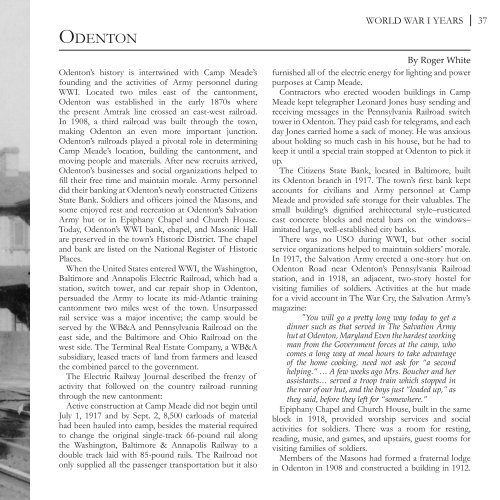Fort George G. Meade: The First 100 Years
You may know Fort George G. Meade as a cyber and intelligence hub, but did you know that the installation used to be the home of Army Tank School after World War I? Or that it housed an internment camp at the start of World War II for primarily German-American and Italian-American citizens and foreign nationals? Learn more about the fascinating history of the third largest Army base in the U.S. in terms of number of workforce in this book.
You may know Fort George G. Meade as a cyber and intelligence hub, but did you know that the installation used to be the home of Army Tank School after World War I? Or that it housed an internment camp at the start of World War II for primarily German-American and Italian-American citizens and foreign nationals? Learn more about the fascinating history of the third largest Army base in the U.S. in terms of number of workforce in this book.
Create successful ePaper yourself
Turn your PDF publications into a flip-book with our unique Google optimized e-Paper software.
Odenton<br />
Odenton’s history is intertwined with Camp <strong>Meade</strong>’s<br />
founding and the activities of Army personnel during<br />
WWI. Located two miles east of the cantonment,<br />
Odenton was established in the early 1870s where<br />
the present Amtrak line crossed an east-west railroad.<br />
In 1908, a third railroad was built through the town,<br />
making Odenton an even more important junction.<br />
Odenton’s railroads played a pivotal role in determining<br />
Camp <strong>Meade</strong>’s location, building the cantonment, and<br />
moving people and materials. After new recruits arrived,<br />
Odenton’s businesses and social organizations helped to<br />
fill their free time and maintain morale. Army personnel<br />
did their banking at Odenton’s newly constructed Citizens<br />
State Bank. Soldiers and officers joined the Masons, and<br />
some enjoyed rest and recreation at Odenton’s Salvation<br />
Army hut or in Epiphany Chapel and Church House.<br />
Today, Odenton’s WWI bank, chapel, and Masonic Hall<br />
are preserved in the town’s Historic District. <strong>The</strong> chapel<br />
and bank are listed on the National Register of Historic<br />
Places.<br />
When the United States entered WWI, the Washington,<br />
Baltimore and Annapolis Electric Railroad, which had a<br />
station, switch tower, and car repair shop in Odenton,<br />
persuaded the Army to locate its mid-Atlantic training<br />
cantonment two miles west of the town. Unsurpassed<br />
rail service was a major incentive; the camp would be<br />
served by the WB&A and Pennsylvania Railroad on the<br />
east side, and the Baltimore and Ohio Railroad on the<br />
west side. <strong>The</strong> Terminal Real Estate Company, a WB&A<br />
subsidiary, leased tracts of land from farmers and leased<br />
the combined parcel to the government.<br />
<strong>The</strong> Electric Railway Journal described the frenzy of<br />
activity that followed on the country railroad running<br />
through the new cantonment:<br />
Active construction at Camp <strong>Meade</strong> did not begin until<br />
July 1, 1917 and by Sept. 2, 8,500 carloads of material<br />
had been hauled into camp, besides the material required<br />
to change the original single-track 66-pound rail along<br />
the Washington, Baltimore & Annapolis Railway to a<br />
double track laid with 85-pound rails. <strong>The</strong> Railroad not<br />
only supplied all the passenger transportation but it also<br />
WORLD WAR I YEARS<br />
By Roger White<br />
furnished all of the electric energy for lighting and power<br />
purposes at Camp <strong>Meade</strong>.<br />
Contractors who erected wooden buildings in Camp<br />
<strong>Meade</strong> kept telegrapher Leonard Jones busy sending and<br />
receiving messages in the Pennsylvania Railroad switch<br />
tower in Odenton. <strong>The</strong>y paid cash for telegrams, and each<br />
day Jones carried home a sack of money. He was anxious<br />
about holding so much cash in his house, but he had to<br />
keep it until a special train stopped at Odenton to pick it<br />
up.<br />
<strong>The</strong> Citizens State Bank, located in Baltimore, built<br />
its Odenton branch in 1917. <strong>The</strong> town’s first bank kept<br />
accounts for civilians and Army personnel at Camp<br />
<strong>Meade</strong> and provided safe storage for their valuables. <strong>The</strong><br />
small building’s dignified architectural style–rusticated<br />
cast concrete blocks and metal bars on the windows–<br />
imitated large, well-established city banks.<br />
<strong>The</strong>re was no USO during WWI, but other social<br />
service organizations helped to maintain soldiers’ morale.<br />
In 1917, the Salvation Army erected a one-story hut on<br />
Odenton Road near Odenton’s Pennsylvania Railroad<br />
station, and in 1918, an adjacent, two-story hostel for<br />
visiting families of soldiers. Activities at the hut made<br />
for a vivid account in <strong>The</strong> War Cry, the Salvation Army’s<br />
magazine:<br />
"You will go a pretty long way today to get a<br />
dinner such as that served in <strong>The</strong> Salvation Army<br />
hut at Odenton, Maryland Even the hardest working<br />
man from the Government forces at the camp, who<br />
comes a long way at meal hours to take advantage<br />
of the home cooking, need not ask for “a second<br />
helping.” … A few weeks ago Mrs. Boucher and her<br />
assistants… served a troop train which stopped in<br />
the rear of our hut, and the boys just “loaded up,” as<br />
they said, before they left for “somewhere.”<br />
Epiphany Chapel and Church House, built in the same<br />
block in 1918, provided worship services and social<br />
activities for soldiers. <strong>The</strong>re was a room for resting,<br />
reading, music, and games, and upstairs, guest rooms for<br />
visiting families of soldiers.<br />
Members of the Masons had formed a fraternal lodge<br />
in Odenton in 1908 and constructed a building in 1912.<br />
37


